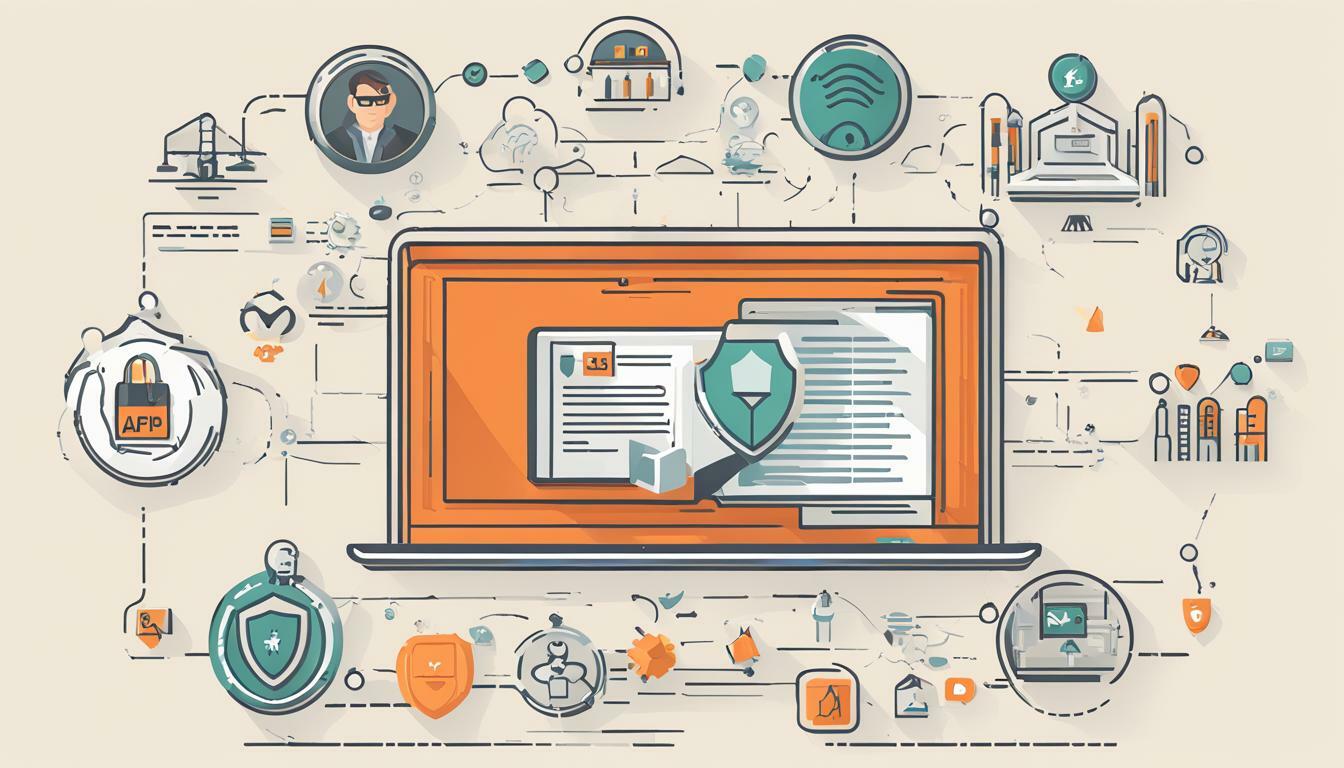
Welcome to our article on API security! In today’s digital landscape, APIs have become a critical component of many applications, providing developers with the ability to integrate third-party services and data into their projects. However, with the rise of API usage, it’s also become increasingly important to ensure secure authentication and authorization strategies to protect sensitive data and resources.
In this article, we will explore the importance of API security and provide strategies for ensuring safe authentication and authorization. We will cover the key concepts and challenges in API security, delve into the various aspects of API authentication, explore the importance of API authorization, and discuss additional security measures that can be implemented to enhance overall API security.
Key Takeaways
- API security is crucial in protecting sensitive data and resources.
- Safe authentication and authorization strategies should be implemented to ensure secure API usage.
- Different authentication and authorization mechanisms, such as API keys, OAuth, and RBAC, can be used to strengthen API security.
- Additional security measures, including API rate limiting, encryption, and secure communication protocols, can be implemented to enhance overall API security.
Understanding API Authentication
API authentication is a critical part of ensuring a secure API. It is the mechanism for verifying that the requesting party has permission to access the API and its resources. Authentication helps prevent unauthorized access to sensitive information and ensures that the API is only accessed by trusted entities.
There are various methods for API authentication, each with its own strengths and weaknesses. Some of the commonly used authentication methods include API keys, OAuth, and JSON web tokens (JWT). The choice of authentication method depends on the specific use case and the level of security required.
API keys are a simple method of authentication that involves using a unique key that is passed with each API request. While API keys are easy to implement, they are vulnerable to attacks such as man-in-the-middle attacks or brute-force attacks. OAuth, on the other hand, is a more robust authentication protocol that allows for delegated authentication. It provides a way for a user to grant limited access to their resources without sharing their credentials.
JSON web tokens are another popular authentication method that provides a way to securely transmit authentication information between parties using a compact and URL-safe format. They are commonly used in modern API architectures and are considered to be a more secure alternative to API keys.
In order to implement secure API authentication, the following best practices should be followed:
- Use strong and unique API keys or access tokens
- Ensure that authentication information is encrypted in transit
- Implement rate limiting to prevent brute-force attacks
- Use multi-factor authentication where possible
- Regularly audit and update authentication mechanisms
By implementing secure authentication measures, API providers can ensure that their API is only accessed by trusted parties and that sensitive information is protected.
Implementing Robust API Authorization
API authorization is a fundamental aspect of API security that ensures the protection of sensitive data and resources. Robust authorization mechanisms help prevent unauthorized access, misuse, and abuse of APIs. API developers must implement secure API authorization techniques to safeguard the integrity, confidentiality, and availability of the API.
There are various API authorization techniques that API developers can use to create secure APIs, such as role-based access control (RBAC), OAuth scopes, and fine-grained access control. RBAC is a widely used approach that grants access to API resources based on the user’s role or job function. OAuth scopes, on the other hand, provide fine-grained access control by specifying the level of access granted to the API client for a particular resource or operation.
API developers can integrate RBAC and OAuth scopes to create a comprehensive API authorization strategy. However, the implementation of RBAC and OAuth scopes should be complemented with other security measures, such as strong authentication and secure communication protocols.
API developers must carefully define the scope of operations that API clients can perform. It’s essential to assess the risks associated with each API operation and grant access to only authorized users. API developers must also ensure that sensitive data is not exposed to unauthorized users and is accessed only by the intended recipients.
API developers should also consider using API gateways, which provide a layer of abstraction between the API clients and the API, to enforce API authorization policies. API gateways can manage the API authorization flow, authenticate users, validate tokens, and enforce access control rules.
Enhancing API Security Measures
While robust authentication and authorization measures are essential, there are additional security measures that can be implemented to enhance API security.
API Rate Limiting
One effective measure is API rate limiting, which controls the number of API requests that can be made within a certain timeframe. This can help prevent potential DDoS attacks and ensure that API resources are not drained by excessive requests.
Encryption
Encryption is another crucial security measure for securing APIs. By encrypting API data in transit and at rest, sensitive information can remain secure. HTTPS/TLS protocols can be used to ensure encrypted communication between client and server, and encrypting data at rest can protect against unauthorized access to sensitive information.
Secure Communication Protocols
Implementing secure communication protocols is also essential for API security. APIs should only be accessed via secure and authorized channels, such as VPNs or secure token-based authentication. This helps prevent unauthorized access and data breaches.
By implementing these additional security measures, API security can be significantly enhanced, providing greater protection for sensitive data and resources. It is essential for developers to prioritize the implementation of these security measures in their APIs to ensure the creation of a secure API.
Conclusion
API security is a critical component of modern software development, particularly as APIs become more prevalent and essential in our daily lives. It is essential to implement robust authentication and authorization strategies to ensure the safe and secure transmission of sensitive data and resources.
As we have discussed, API security can be enhanced through the implementation of various security measures, including encryption, secure communication protocols, and API rate limiting. These measures can help to prevent unauthorized access and mitigate the impact of potential breaches.
Ultimately, the security of APIs must be a top priority for any organization that develops or uses APIs. By prioritizing security and implementing best practices for authentication, authorization, and other security measures, we can ensure that APIs remain a safe and reliable way to interact with our digital world.
FAQ
Q: What is API security?
A: API security refers to the strategies and measures in place to ensure the safe authentication and authorization of API requests, protecting sensitive data and resources from unauthorized access or malicious activities.
Q: Why is API security important?
A: API security is crucial because APIs are often used to access and exchange sensitive data between different systems. Without proper security measures, APIs can become vulnerable to attacks, leading to data breaches, unauthorized access, and potential damage to an organization’s reputation.
Q: What are some common API authentication methods?
A: Common API authentication methods include API keys, OAuth, and JWT (JSON Web Tokens). These methods provide ways to verify the identity of the client making API requests and ensure that only authorized users or systems can access the API.
Q: How can I implement secure authentication in my APIs?
A: To implement secure authentication in your APIs, it is recommended to follow best practices such as using strong encryption protocols, securely storing and managing API keys or tokens, implementing proper user authentication flows, and regularly updating and patching any vulnerabilities in the authentication process.
Q: What is API authorization?
A: API authorization refers to the process of granting or denying access to specific resources or functionalities within an API based on the user’s or client’s identity, permissions, or other defined criteria. It ensures that only authorized individuals or systems can perform certain actions or access certain data.
Q: What are some commonly used API authorization techniques?
A: Commonly used API authorization techniques include role-based access control (RBAC), where access to resources is determined based on predefined roles and permissions, and OAuth scopes, which allow fine-grained access control by specifying the level of access a client has to different resources or actions.
Q: How can I implement robust authorization strategies in my APIs?
A: Implementing robust authorization strategies in your APIs involves properly defining roles and permissions for different users or clients, carefully managing access tokens or tokens, regularly reviewing and updating authorization policies, and ensuring proper auditing and monitoring of API access and authorization events.
Q: What additional security measures can enhance API security?
A: Additional security measures to enhance API security include implementing API rate limiting to prevent abuse or excessive requests, encrypting sensitive data transmitted over the API, and using secure communication protocols such as HTTPS to protect data in transit.








